To do this effectively, firms must look forward and develop predictions as to how new technologies and evolving trends will affect Asia’s manufacturing landscape — including not only which products will sell, but how those products will help end users to be ahead of competition. Five industry experts weighed in on which trends we’ll be looking for in the 2018 manufacturing supply chain.

Wai Yip Lee, General Manager of Hurco (S.E. Asia) Pte Ltd
Thailand is more than a favourite tourist destination. It is one of the world’s leaders in automotive manufacturing industry. While the past two years can be considered tough for Thailand’s automotive industry because of several negative factors, 2018 promises an interesting mix of technological innovations.
“We see some recovery for 2018 in the automotive sector. Thai manufacturers are starting to look at improving their productivity, reducing set-up time for their existing parts. And also to take on more challenging machining jobs that require very precise machines and at the same time more access to approach a top geometry. So we think that 5-axis will have a lot of potential for growth," Lee said.
Hurco will be focusing more on the mid-range and the high-range machining centers, especially more on the 4-axis, and 3- to 5-axis range. He added, "We do see that competition coming from places like Vietnam and Indonesia.”
"When asked if Hurco’s 5-axis machining center is Industry 4.0 ready, Wai Yip explains “At Hurco, we don’t just build machining centers. We have our own controllers. Industry 4.0 is what everybody is talking about. As a control builder as well, our controls is Window space, so in terms of extracting data and linking up online system to manage workflow (ERP system, manufacturing workflow system itself), there are capabilities that are built within the control to allow that. In advanced markets like America and Germany, we are really working with different partners on getting the critical information from the machine to the system itself so that it can be incorporated to the whole Industry 4.0 plan.”
He added, “On a smaller scale, customers are looking at Industry 4.0 on a big scale but on a smaller scale there are capabilities that are built within the controller that allows the customer to extract data like spindle hours, spindle utilisation, machine utilisation and stuff like that. And all that are being presented in a graphical format. Customers can just log in to our own Hurco Extended Shop Floor Platform, which is an option, and they could just look at how the machine is moving. If a customer has for example three Hurco machines in different locations, even in three different countries, they can know the productivity of individual machine and individual departments by just simple click and by looking at the computer screen itself.”

Masaki “Sox” Konno, Managing Director, Asia Pacific South, Dassault Systèmes
Industry 4.0 brings forth more of a smart factory setting where devices on the factory floor will get more connected. Smart tooling will provide better real-time feedback to machine controllers, send alerts to engineers for adjustments that need to be made, and increase the overall efficiency of production. The greater connectivity will also allow for more collaboration to take place between factories, increasing opportunities for employees within organisations to innovate. Additionally, feedback provided by these connected devices can be enhanced through 3D technology to run real time data analysis and drive insights into factory floor operations to help manufacturers quickly spot potential problems.
In fact, 3D technology is already playing a major role in creating new metalworking trends – 3D printing, for instance, presents the industry with more possibilities for product design. For many products, 3D also significantly shortens time taken for them to go from concept to reality. Manufacturers can develop entire products using 3D technologies, refine and test virtual prototypes, before anything needs to touch a physical assembly line. With Industry 4.0 becoming more of a reality, 3D technology will play a crucial role in its success and the growth of the metalworking industry.

Max Lu, Sales Manager, Palmary Machinery Co. Ltd
Palmary has entered the Thailand market 20 years ago, Max observed a few main trends in Thailand based on his long-term experience. He identified the need of upgrade from NC to CNC, from heavily labour-intense to use of robots, and also mass demands in overhauling machines.
Thus, Palmary has carried out a great amount of overhauling maintenance projects across Thailand, in meeting changing manufacturing types needed in automobile and mould & die industry. At the moment, Japanese offshore auto manufacturing suppliers take up 60% of Palmary’s Thailand demand, in the areas of transmission, engine system and more.
The company’s CNC cylindrical grinding machine, called OCD-3225CAM, is capable of grinding various special shaped workpiece when in combination with angle control of spindle by C axis (built-in spindle motor). Furthermore, the feed axis is driven by linear motor and DD motor, equipped with close loop control optical scale to reach high precision. Regarding the digital system that is becoming an ever more crucial heart of machine tools, CNC cylindrical grinding machine OCD-3225CAM is equipped with conversational control system that is easy to operate.
Another highlight that gave the cylindrical grinder a green touch is embedding oil mist collector, collaborated with partner AIR-O-FILTER, the oil mist collector is designed for machine tools to eliminate mist, smoke and odour’s typical of wet machining operation in metal cutting applications.
“This is one of the biggest change of our machine to leap into the concept of environmentally-friendly manufacturing”, exclaimed Max Lu. On the other hand, with another collaborator Palmary installed cooler management system, which purify and separate waste oil and water to a pure state for reuse. The equipment improves the efficiency and reduces energy consumption of cylindrical grinder all together.
Lu shared practical examples of how Palmary’s machine will benefit customers’ factory. By special arrangement, the production capacity can increase more than 30 % if combined with robot type auto loading and unloading system plus Inspection system, modified to do two pieces In-feed grinding.
Max Lu is very positive about the prospect of the ASEAN market. He said, “Although the competition is becoming more intense from multinational manufacturers in Thailand, we stand still in focusing on refining our grinding technology, as it is the final procedure in metalworking it also requires higher entry barriers. That is why we can experience 30% growth more than that in 2016.” Palmary is now trying to enter new industrial zones in different provinces of Thailand.

Michael Willome, Chief Executive Officer, Conzzeta AG
Conzzeta is a broadly diversified Swiss group of companies. It stands for innovation, reliability and a long-term perspective. It strives for leading positions in its target markets, above-average growth and long-term value creation. The business units - Sheet Metal Processing, Sporting Goods, Foam Materials, Graphic Coatings and Glass Processing - focus, with innovative solutions, on customer benefits.
The most important achievements of Conzzeta during the last two years in terms of sheet metal processing is first our market development through the expansion of footprint and investment in human resources in Asia, and our products: ByStar Fiber 10kW and Xpert 40 with Mobile Bending Cell. Accompanied by a comprehensive range of services. However, the biggest challenge is to agree on standards and develop products and services that bring value to the customers.
Conzzeta believes in Asia. “We believe in a strong local presence and we are committed to support the growth and development of the sheet metal industry in Asia. That is our promise to the market and to our valuable customers. We will continuously strive for a close and uncomplicated relationship with our customers and partners,” he added.

Andreas Wank, Executive Director of the SME 4.0 Competence Centre in Darmstadt
Large corporations sometimes have things easier when it comes to Industry 4.0. They are more likely to have funds available to build a new greenfield factory in which they can without risk try out and introduce the new digital approaches involved. The situation is rather different at small and mid-tier companies, who in most cases will find it difficult to digitalise their existing brownfield production facilities. They should accordingly as a first step think very carefully about what specific ratios they wish to improve.
"We tackle digitalisation primarily in terms of methodology,” he explains. “The focus here is not on replacing human work, but on complementing it.” For this purpose, he continues, it’s necessary in the digital process to automate activities that had hitherto been performed manually, like acquiring and entering measured data. Here, for example, the experts use their Value Flow Analysis 4.0 to identify cases of digital waste in manufacturing processes. These include digital media interruptions, where data are either not being acquired or not being forwarded. To quote Andreas Wank: “Often measured data are entered in the measuring computer by hand, but no regular analyses are performed and the information involved is not forwarded.”
First-time users should accordingly start by learning to understand their processes and stabilising them before proceeding to digitalise them. “It’s often not worthwhile entering directly into further digitalisation if you don’t know precisely what the processes look like,” explained Andreas Wank. “Things mostly go wrong when someone tries to eliminate chaos with digitalisation.” When analysing a company in Hesse with a high level of variant diversity, for example, his staff discovered that the information flow between Purchasing, Production Planning and Assembly was not functioning flawlessly. Digitalisation had already failed in the first step because no one properly understood the sequence of the information flow.”
Air Jordan IV 4 Retro Denim













